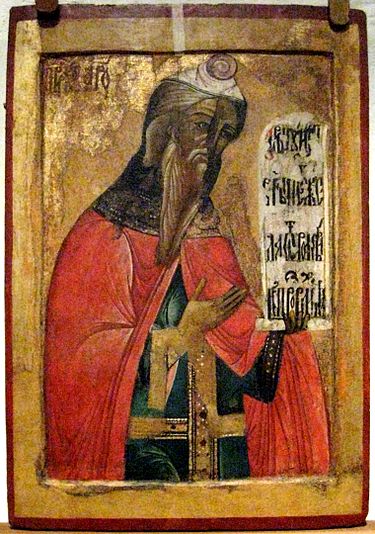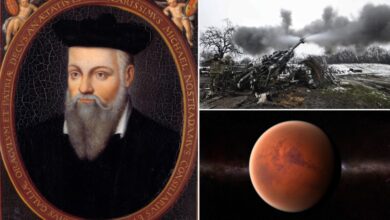
AARON, or, in Hebrew, Aharon
Israelite leader and priest who flourished, according to tradition, in the thirteenth century BCE. In its redacted form, the Pentateuch provides a fairly complete biography of Aaron, the first priest in the biblical tradition. Born to Amram and Jochebed of the Levite tribe when the Israelites were slaves in Egypt, he was the elder brother by three years of the great prophet-leader Moses, and he assisted Moses in liberating the Israelites and leading them through the Sinai wilderness to the Promised Land of Israel. Israel’s God, YHVH, instructed Moses to appoint Aaron and his sons as the exclusive priests of the people, and Aaron ministered in the capacity of chief priest until he died, in the last year of the journey.
Most Bible scholars, however, regard this unified picture of the life and role of Aaron as a relatively late invention of the so-called Priestly school (the P source). Biblical tradi- tions concerning Aaron present diverse views. In addition to the Priestly representation, in which the functions of Aaron and his sons establish precedents for the official priests of all succeeding generations (see, for example, Exodus 30:10, 40:15, and Leviticus 6:11), Aaron is remembered as a military-political leader who acts as a lieutenant of Moses in the Israelites’ battle against the Amalekites (Ex. 17:12) and who serves as a magistrate in Moses’ absence (Ex. 24:14). Aaron is cited as a leader of the Exodus in Micah 6:4 and in Psalms 77:21.
Aaron also fulfills an apparently prophetic role. He serves as Moses’ spokesman to the Israelites and to the pharaoh of Egypt, performing magical feats by the power of YHVH. In Numbers 12, Aaron and his sister Miriam challenge Moses’ unique prophetic status, claiming revelation for themselves as well, but YHVH rebukes them.
Two Pentateuchal narratives revolve around the legitimacy of Aaron’s priesthood. In Numbers 17:16ff. Moses vindicates Aaron: he inscribes the names of the tribes on twelve poles, but only the pole of the Levite tribe, bearing Aaron’s name, sprouts blos- soms. In Exodus 32 Aaron succumbs to the people’s plea to construct a physical image of God and makes a golden calf. The Pentateuch (Ex. 32:35, Dt. 9:20) condemns Aaron for this apostasy and appears to favor those Levites associated with Moses over the priests represented by Aaron.
Aaron’s golden calf is generally associated with the calves set up centuries later by King Jeroboam I (r. 928–907 BCE) in the far northern town of Dan and in the central town of Bethel after the northern tribes of Israel seceded from the Israelite empire circa 920 BCE. On the basis of this, and of the connection of Aaronite priests to Bethel mentioned in Judges 20:26–28, some scholars have concluded that Aaron was the founder of the northern priesthood, which was later assimilated into the Jerusalem priesthood. Others believe that the Aaronites originated in the south and because of their traditional legitimacy were appointed to positions in the northern cult.
As the various traditions were combined in the Penta- teuch, Aaron became the paradigm of the priest and Moses of the prophet, but Aaron’s role was clearly subordinated to that of his younger brother.
BIBLIOGRAPHY
The most commonly held reconstruction of the history of the Isra-
elite priesthood and the place of Aaron and the Aaronites in it is Aelred Cody’s A History of Old Testament Priesthood (Rome, 1969), which also contains a comprehensive bibliog- raphy. An important revision of the common theory is Frank Moore Cross’s Canaanite Myth and Hebrew Epic: Essays in the History of the Religion of Israel (Cambridge, Mass., 1973), pp. 195–215. For the view that Aaron was the founder of the northern Israelite priesthood, see Theophile J. Meek’s He- brew Origins (1936; reprint, New York, 1960), pp. 31–33, 119–147. Extensive analyses of the Aaron passages in the Pentateuch can be found in Hugo Gressmann’s Mose und seine Zeit: Ein Kommentar zu den Mose-sagen (Göttingen, 1913), pp. 199–218, 264–283, 338–344. The most compre-
hensive history of the scholarly debate, with a detailed liter- ary-historical analysis of the pertinent biblical passages, is Heinrich Valentin’s Aaron: Eine Studie zur vor- priesterschriftlichen Aaron-Überlieferung (Göttingen, 1978).
EDWARD L. GREENSTEIN (1987)
C LOCKWISE FROM TOP LEFT CORNER . Fourteenth-century BCE terra-cotta hedgehog of Aegean Rhyton, from Ugarit, Syria. Louvre, Paris. [©Erich Lessing/Art Resource, N.Y.]; Facsimile of prehistoric paintings in Lascaux Cave in southwestern France. Musée des Antiquites Nationales, France. [©Réunion des Musées Nationaux/Art Resource, N.Y.]; Ancient Egyptian underworld god Anubis. Cairo Museum. [©Roger Wood/Corbis]; Pyramid of the Sun at Teotihuacan, Mexico. [©Charles & Josette Lenars/Corbis]; Late-nineteenth-century brass Altar of the Hand shrine from Benin. British Museum, London. [©HIP/Scala/Art Resource, N.Y.].
